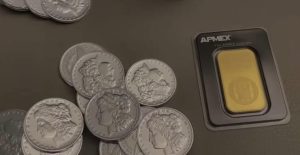
In the world of precious metals investment, gold bullion coins have long held a special place as a tangible and valuable asset. Investors often seek reputable sources for acquiring these coins, and one question that frequently arises is whether retail giants like Walmart offer gold bullion coins for sale.
In this article, we’ll delve into this query, exploring the possibilities and considerations related to purchasing gold bullion coins at Walmart.
Gold Bullion Coins: An Overview
Before we explore the availability of gold bullion coins at Walmart, it’s essential to understand what gold bullion coins are and why they hold such allure for investors. Gold bullion coins are coins that are minted from pure gold or gold alloys, and their value is primarily derived from the precious metal content they contain. Unlike numismatic coins, which derive value from their rarity and historical significance, gold bullion coins are prized for their intrinsic value as a form of investment.
These coins are typically issued by government mints or reputable private mints, and they come in various sizes and denominations. Some of the most well-known gold bullion coins include the American Gold Eagle, the Canadian Gold Maple Leaf, the South African Krugerrand, and the Australian Gold Kangaroo. Their purity and weight are guaranteed by the issuing authority, making them a trusted choice for investors looking to diversify their portfolios.
Now that we’ve established what gold bullion coins are, let’s delve into the question at hand: Does Walmart sell gold bullion coins?
Walmart’s Retail Dominance
Walmart is a household name, known for its vast network of stores across the United States and beyond. The retail giant offers a wide range of products, from groceries and clothing to electronics and home goods. Due to its extensive reach and diverse product offerings, many consumers wonder whether Walmart also caters to the needs of precious metals investors.
Walmart’s Business Model
To understand whether Walmart sells gold bullion coins, we must examine the company’s business model and product selection. Walmart primarily operates as a discount retail store, aiming to provide consumers with everyday products at competitive prices. While they excel in many retail categories, the focus of their business has historically not included the sale of specialized investment products like gold bullion coins.
Precious Metals vs. Walmart
Gold bullion coins fall into the category of precious metals, and their trade involves unique considerations compared to other consumer goods. These coins are valued for their purity and weight, and they are typically bought and sold in the investment and numismatic markets. Unlike everyday products, the pricing and sourcing of gold bullion coins are subject to international market forces, making them a niche within the broader retail landscape.
Walmart’s Product Range
Walmart primarily caters to the general consumer market, offering a wide range of products designed for everyday use. Their stores stock items like groceries, clothing, electronics, home appliances, and more. However, when it comes to specialized investment products like gold bullion coins, Walmart’s product range has traditionally not included such items.
It’s important to note that Walmart’s core business strategy centers around providing consumers with essential and widely used products at affordable prices. While they may have limited selections of jewelry and watches, these offerings are typically geared towards fashion and everyday wear rather than investment-grade precious metals.
Specialized Precious Metals Dealers
Investors seeking to purchase gold bullion coins often turn to specialized precious metals dealers, both online and in physical locations. These dealers specialize in precious metals investments and provide a range of products, including gold bullion coins, silver coins, platinum coins, and bars of various sizes and weights. Unlike general retailers like Walmart, these dealers are well-versed in the precious metals market and can offer investors a wider selection and more tailored services.
Factors to Consider When Buying Gold Bullion Coins
If you’re interested in acquiring gold bullion coins for investment purposes, there are several factors to consider, regardless of whether you’re looking at Walmart or other sources:
- Authenticity: Ensure that the coins you purchase are genuine and come with proper documentation and certifications of authenticity.
- Purity: Verify the purity of the gold in the coins. Most gold bullion coins are made of .9999 fine gold.
- Pricing: Understand the pricing structure, including premiums over the spot price of gold, which can vary among dealers.
- Security: Consider how you will store and secure your investment, as gold bullion coins represent a valuable asset.
- Reputation: Choose a reputable dealer with a track record of honesty and transparency in their dealings.
We’ve explored the world of gold bullion coins and their intrinsic value as investment assets. While Walmart is renowned for its extensive retail presence, the retail giant’s business model primarily focuses on providing everyday consumer products rather than specialized investment-grade assets like gold bullion coins.
For investors looking to add gold bullion coins to their portfolio, specialized precious metals dealers with expertise in the precious metals market may be a more suitable option. In the next section, we will continue our exploration by examining alternative sources for purchasing gold bullion coins and providing insights into the factors to consider when making such investments.
Alternative Sources for Purchasing Gold Bullion Coins
In the first part of this article, we discussed the absence of gold bullion coins in Walmart’s product range and the importance of specialized precious metals dealers for investors seeking these assets. In this section, we will delve deeper into alternative sources for purchasing gold bullion coins and address some frequently asked questions (FAQs) related to this investment.
Alternative Sources for Gold Bullion Coins
- Precious Metals Dealers: Specialized precious metals dealers are one of the most common and reliable sources for purchasing gold bullion coins. These dealers offer a wide range of options, including coins from various government mints and private mints. They can provide investors with access to a diverse selection of coins, including popular choices like the American Gold Eagle, Canadian Gold Maple Leaf, and South African Krugerrand.
- Online Retailers: Many reputable online retailers specialize in precious metals and offer a convenient platform for buying gold bullion coins. These platforms often provide a wealth of information about the coins they sell, including pricing, purity, and available denominations. It’s essential to research the credibility of the online retailer before making a purchase, as the online market can vary in terms of trustworthiness.
- Local Coin Shops: Local coin shops, often referred to as numismatic or coin dealerships, can be excellent sources for gold bullion coins. These shops may carry a selection of both bullion and numismatic coins, catering to a range of collectors and investors. Visiting a local shop allows you to inspect the coins in person and potentially establish a relationship with a knowledgeable dealer.
- Auctions and Marketplaces: Auction houses and online marketplaces like eBay occasionally feature gold bullion coins for sale. However, buyers should exercise caution when purchasing from these sources, as prices can fluctuate significantly, and it may be necessary to evaluate the credibility of individual sellers.
- Government Mints: Some government mints, such as the U.S. Mint and the Royal Canadian Mint, offer gold bullion coins directly to the public. Purchasing directly from a government mint can provide assurance of authenticity and quality, but availability and pricing may vary.
- Private Mint Distributors: In addition to government-issued coins, private mints also produce gold bullion coins. Distributors or dealers affiliated with these private mints can offer a range of options. Be sure to verify the reputation of both the distributor and the mint.
Frequently Asked Questions (FAQs)
- Are gold bullion coins a good investment?
- Gold bullion coins can be a valuable addition to a diversified investment portfolio. They are sought after for their intrinsic value and have historically acted as a hedge against economic uncertainty and inflation.
- What is the difference between gold bullion coins and numismatic coins?
- Gold bullion coins are valued primarily for their precious metal content, whereas numismatic coins derive value from factors such as rarity, historical significance, and collector demand.
- How do I know if a gold bullion coin is authentic?
- To verify the authenticity of a gold bullion coin, ensure it comes with proper documentation and certifications. Reputable dealers and government mints provide such documentation.
- What is the spot price of gold, and how does it affect the cost of gold bullion coins?
- The spot price of gold is the current market price for one troy ounce of pure gold. The cost of gold bullion coins is influenced by this spot price, with premiums added to cover production costs and dealer margins.
- What is the best size and type of gold bullion coin for investment?
- The choice of gold bullion coin size and type depends on your investment goals and preferences. Common choices include 1-ounce coins, but fractional sizes are also available. Popular options include the American Gold Eagle, Canadian Gold Maple Leaf, and South African Krugerrand.
- How should I store gold bullion coins?
- Storing gold bullion coins securely is crucial. Options include bank safe deposit boxes, home safes, or secure storage facilities. Consider insurance to protect your investment.
- Should I buy gold bullion coins for short-term or long-term investment?
- Gold bullion coins can serve both short-term and long-term investment objectives. Some investors acquire them as a hedge against economic uncertainty, while others view them as a long-term store of value.
Conclusion
In this second part of the article, we explored alternative sources for purchasing gold bullion coins, emphasizing the importance of specialized dealers, online retailers, local coin shops, auctions, government mints, and private mint distributors. Each of these sources has its advantages and considerations, and investors should conduct thorough research before making their choice.
Additionally, we addressed some frequently asked questions related to gold bullion coin investments, providing insights into authenticity verification, the impact of spot prices, storage options, and the suitability of various coin sizes and types for investment purposes.
Ultimately, the decision to invest in gold bullion coins is a significant one, and it’s crucial for investors to approach it with careful consideration, informed decision-making, and a clear understanding of their investment goals and preferences. Whether as a short-term hedge or a long-term store of value, gold bullion coins remain a fascinating and enduring asset class in the world of investments.



